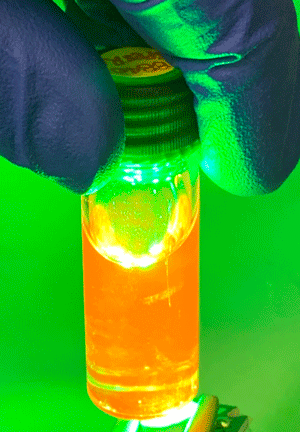| Apr 08, 2021 |
From total lack of knowledge about nanodots to total control of their properties
(Nanowerk News) Carbon nanodots are spherical nanoparticles (measuring about 3 or 4 millionths of a millimeter comprising about 200-300 atoms) made up of carbon, hydrogen, oxygen and other atoms that can be added, such as nitrogen or sulfur; they are synthesized when organic molecules are subjected to temperatures of between 200 and 300 °C.
|
|
Solubility in water and other solvents plus the intense luminescence of these nanodots means that their properties are ideal for use in biomedical imaging with applications in new therapies as well as in diagnostics.
|
|
“The structure of nanodots is not yet fully known. At the temperatures to which reagents are subjected, structures that are considerably more complicated than the original ones are produced, and we have yet to find out about them. We know that it is possible to adjust their properties depending on the method of synthesis, in other words, by using different compounds to form them,” explained the Ikerbasque professor and AXA Chair Maurizio Prato.
|
 |
| Dissolution of carbon nanodots illuminated by an LED lamp with visible light. The photo shows the typical fluorescence of nanodots. (Image: CIC biomaGUNE)
|
|
CIC biomaGUNE’s Carbon Bionanotechnology Group led by Prato has just launched the e-DOTS project. It is a basic research project that aims to “explore the structure and properties of nanodots so that they can be synthesized with the exact properties we want them to have”, said Prato. This research project with great potential is supported by funds from the European Research Council (ERC) awarded in 2020 as part of the provision by the prestigious ERC Advanced Grants (2.5 million euros over 5 years). These are funds for projects that may involve significant steps forward and offer solutions for some of the current major challenges. The ERC has deemed this project to have the potential to transform nanodots from a purely academic level right up to a level of application in nanomedicine and in medical science, in general.
|
|
“We started working with nanodots in 2016 and gradually realized that they constitute a very interesting material. According to how they are synthesized, it is possible to obtain nanodots with very different properties, and which can be used in various applications. The main aim of the project is to be able to acquire detailed knowledge about the structure, chemical reactivity and properties of these materials, so that we can understand how they are formed and be able to modify them as we want: starting from a reproducible, reliable preparation and ending up with the capacity to control their properties,” said Prof Prato.
|
Automated machine learning system to discover new nanodots
|
|
On this journey the research group will be availing itself of a machine learning system. “We are applying an automated system to discover new nanodots by using a method to optimize their synthesis; in other words, a kind of robot that prepares new nanoparticles, analyzes them and tells us whether the properties are better or worse than we anticipated; this will help us to understand how to synthesize the best nanodots or how we can enhance their properties," explained Prato. “In other words, by inputting a large quantity of data into the system, the system will indicate to us what the best experimental conditions could be to obtain the properties we are seeking.”
|
|
Studying the fundamental aspects of carbon nanodots in depth will enable their whole potential to be deployed across technological and biological applications, which could range from high-quality bioimaging to green catalysis in water.
|
|
“They can be used in organic catalysis systems to obtain compounds with a high added value. We also hope to synthesize contrast agents for magnetic resonance imaging; and in addition, if we insert therapeutic molecules into these nanodots, we can use them not only for therapeutic but also for diagnostic purposes (this emerging field is called theragnostics),” explained the Ikerbasque professor. The Ikerbasque professors Jesús Ruíz-Cabello and Pedro Ramos, CIC biomaGUNE specialists in the field of molecular imaging, will be collaborating with Prof Prato on this aspect.
|
|
It will also be possible to use them as markers in biological systems, “so, depending on the external structure of the nanodots, we will be able to guide them to a specific type of cell, in other words, this system could help us spot cancer cells”. To do this, he stressed that it is important to establish a biosecurity profile of the nanodots, because “how they react with cells and living beings is not yet fully known. It is important to be sure that they are totally harmless”, although he predicts that, according to the studies they have conducted already, “it can be seen that they are free of any toxicity”.
|
|
Other CIC biomaGUNE groups, world-class experts in magnetic resonance imaging, are collaborating in the project with a view to applying nanodots as contrast media. Furthermore, part of the work will be conducted in collaboration with the University of Trieste in Italy and with the Elettra Sincrotrone Trieste research center.
|
|
“We hope to be able to achieve a level of complexity and perfection that will enable us to apply nanodots to significant biomedical applications.” To recap, Prato said, “It is necessary to work in stages; so it is a question of perfecting the synthesis and purification of the nanodots, so as to be able to subsequently tackle the issue of applications, which call for a high degree of reproducibility and purity due to the fact that they are biomedical ones."
|

